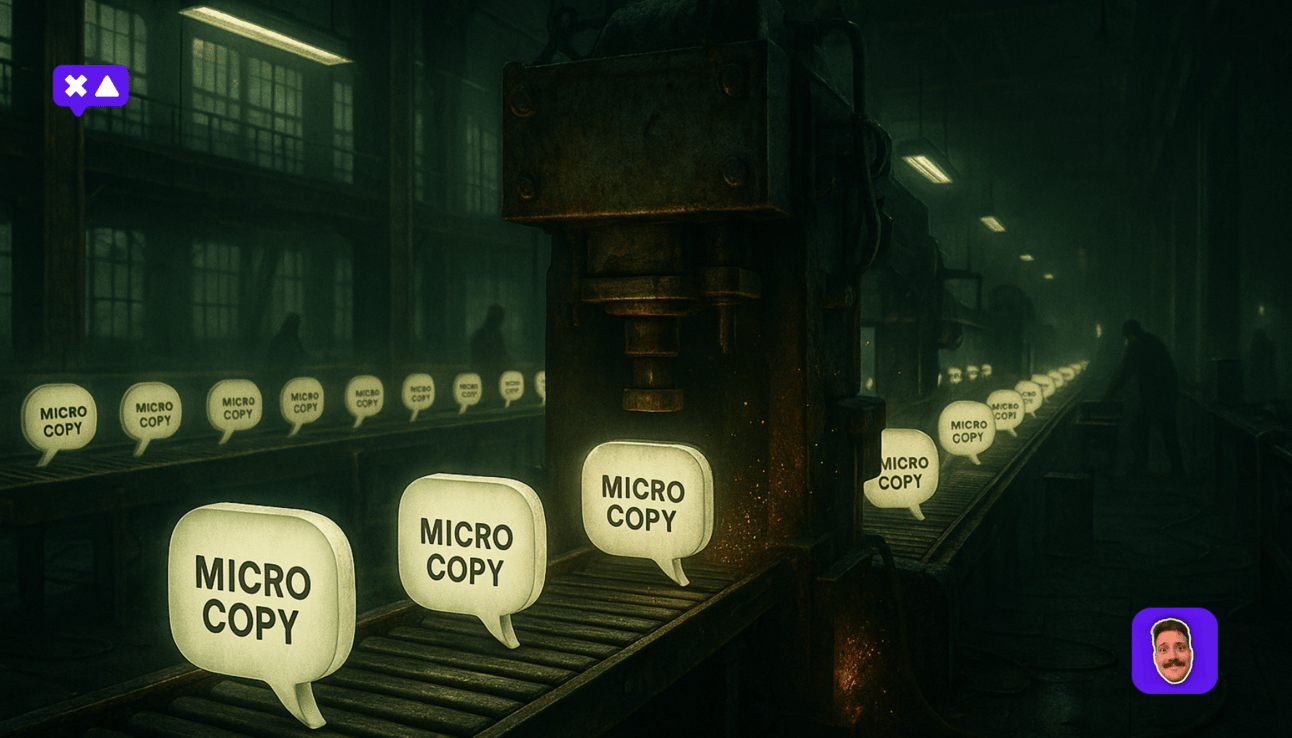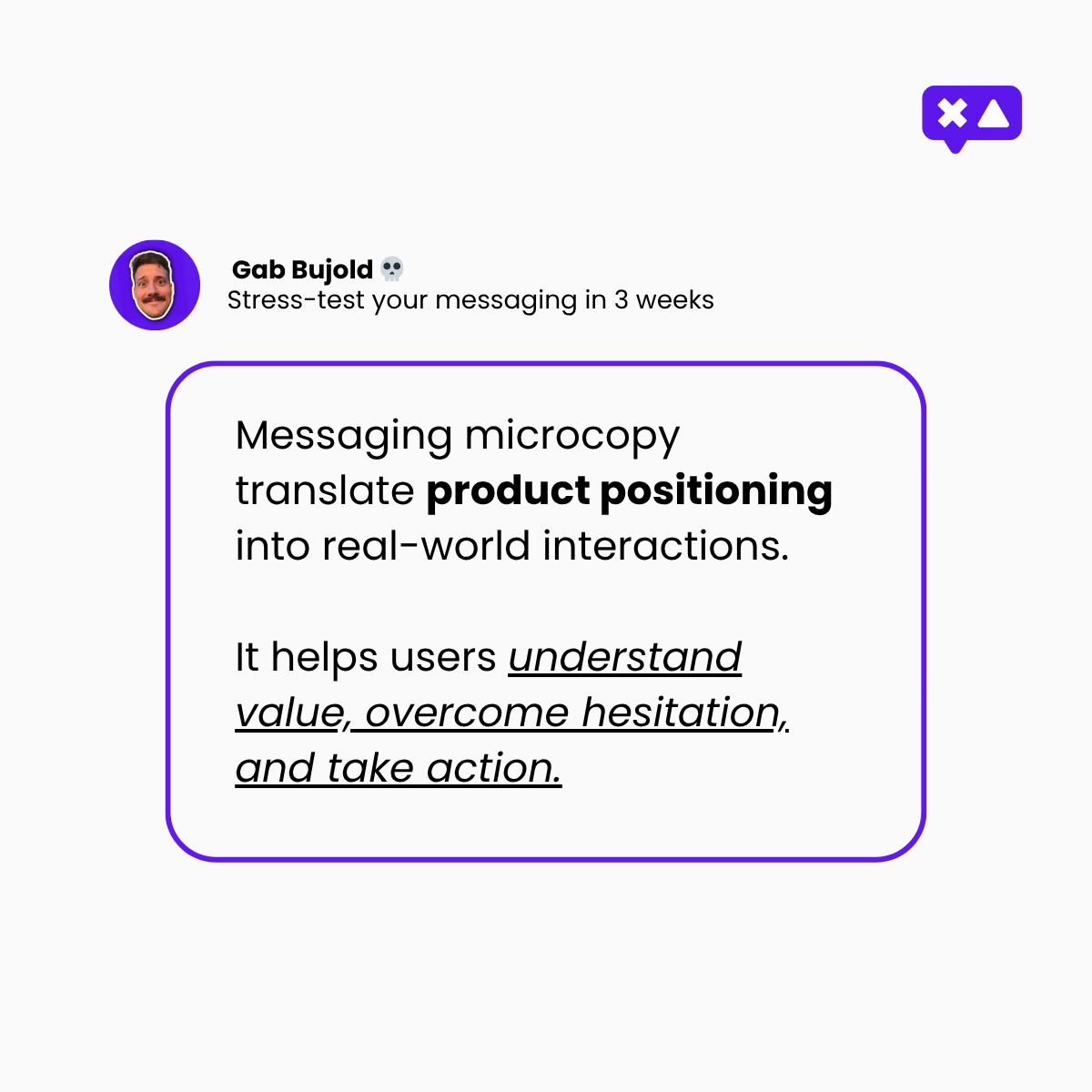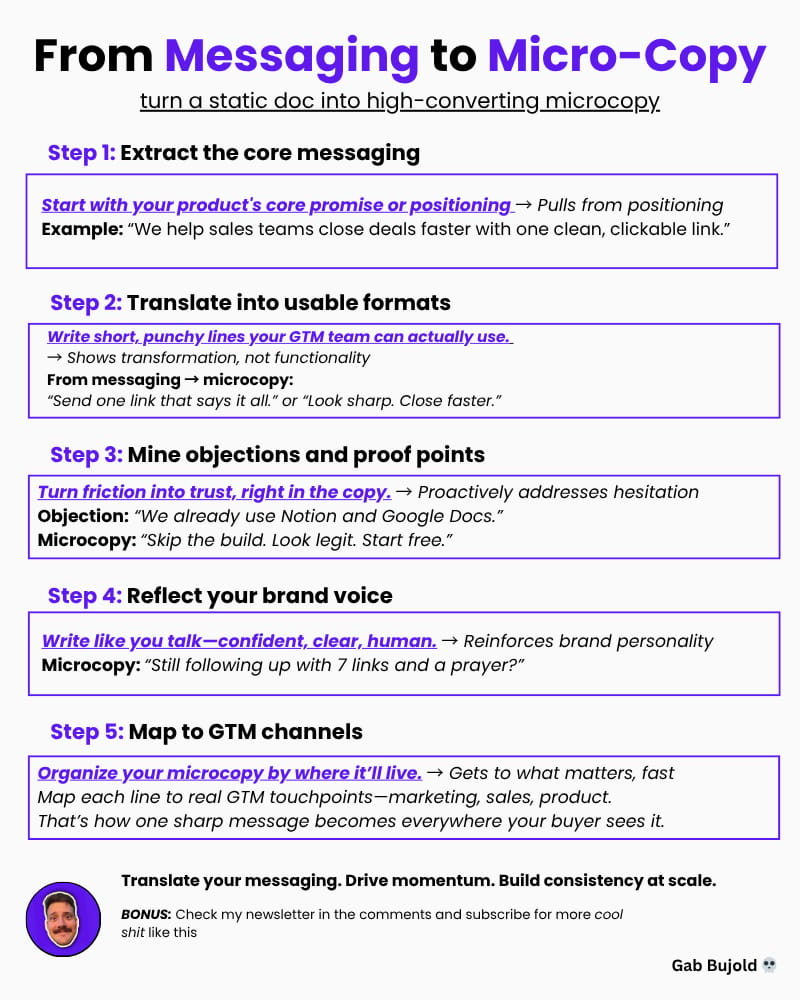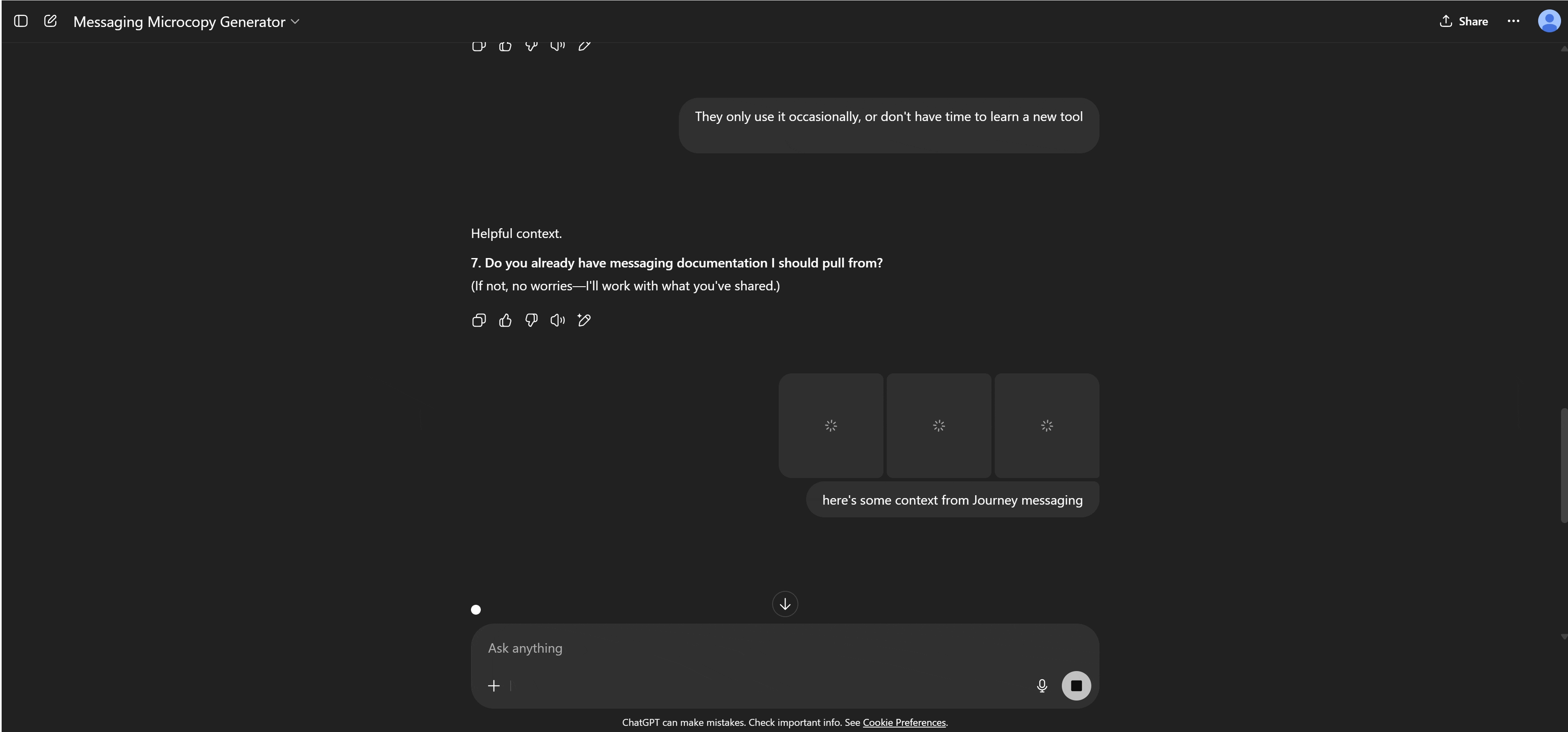- Messaging Sherpa
- Posts
- The secret power of consistent messaging: Microcopy
The secret power of consistent messaging: Microcopy
Why translating messaging into short, usable microcopy builds consistency across your GTM

Consistency is the key to everything 🗝️
Because it compounds and that’s when you start reaping the rewards.
When I started bouldering, the hardest thing was small tiny holds called crimps because it required enough tendons strength. So I started going twice a week, so I could make my climbing consistent and hold these crimps.
That consistency made me progress super fast—the sessions weren’t super long but lasted long enough to increase my tendons strength and endurance.
The reason I’m telling you this?
The same goes with your messaging, if it’s not consistent, you’ll never develop the endurance to create mindshare in your prospects mind.
And the best way to be continuously impacting prospects with your messaging is with microcopy
Here’s how to create multiple variations that will make your messaging consistent and turn prospect interest into buying intent.
Otherwise, you’re just creating confusion at scale.
But what the hell is microcopy?
“Microcopy is the short, contextual text that helps users interact with a product or service.”
It’s more of a product term than anything else, but I believe it’s a must for product marketing teams because of the inconsistency covered earlier.
So here’s my definition for messaging microcopy:
“Messaging microcopy refers to the short, strategic lines of copy that translate product positioning into real-world interactions. It bridges the gap between marketing and UX, helping users understand value, overcome hesitation, and take action.”

So with this context in mind, let’s get started:
Why inconsistent messaging is causing churn
When we think inconsistency as marketers, we’re often blaming it on sales (at least I’ve used to)
The best salespeople are crushing it, while the bottom ones are struggling. This happens when the team is scaling and because there’s no established relationship between marketing and sales.
BUT that’s not the only issue, it’s a product promise problem. Your prospects and customers expectation are mismatched, and that lead to unhappy customers and high churn.
👉 When every team interprets your positioning differently, you’re creating confusion at scale, that’s why you need a bridge between your messaging and your stakeholders.
Here’s an example that happened with a series A startup:
Their team was around 7 BDRs (business development representative), and they had scattered messaging documentation, but it was up to them to figure out how to write emails or DMs with it. Even with solid positioning and a polished deck, it didn’t matter:
→ A value prop won’t really help a sales person trying to get to their quota, they can’t just add it to every email, they need to experiment with prospects
Good messaging is a pressure-test of your positioning, so your copy should be a clever way to communicate your messaging, but not everyone is on the same level of cleverness or creativity.
In enterprise, I was running project briefs and going over the positioning and messaging every. single. time.
But the outputs were nowhere near what I was expecting. ❌
I’m talking customer facing assets like headlines, taglines, slogan, ad copy, subject lines, content, etc. When it’s created by different departments who don’t understand customers as well as you do, gaps and inconsistency happens.
Great marketing is trust at scale, not confusion.
If you don’t make sure that your touchpoints, all across your GTM, are not consistent, you’re losing potential sales and you’re not reassuring customers that you know what you’re doing.
→ That’s why you need microcopy: it takes inspiration from your messaging documentation and craft customer-facing and instantly usable copy for product, marketing, and sales.
Turn your messaging doc into microcopy
The saddest thing about the work we’re doing on messaging is that most of them end up in Drive graveyards, ignored by your team members. And that’s ironic because they belong everywhere your buyer engage with your messaging
And you can’t really blame your colleagues for not reading your messaging docs, it’s an internal-facing strategic document and it’s rarely actionable for sales or marketing (or they just don’t have the instinct to start looking around for it).
You need something that translate that value, fast.
To fix your inconsistent messaging, you need to have the proper messaging documentation (and I’m not talking about the one taking dust in your Drive)
You need to be able to answer these questions clearly, on your product messaging to have enough ammo to craft your messaging microcopy:
What’s your product or company name?
In one sentence, what does your product do?
What problem does your product solve? (Bonus if you’ve written a problem statement.)
Who’s your primary audience? (e.g. HR managers, product teams, small business owners)
What’s the action you want the user to take? (e.g. click, book, upgrade)
Any known objections or hesitations your audience typically has?
Do you already have messaging documentation I should pull from?
From a GTM perspective, you can’t just expect people to craft great copy AND truthful to your messaging without becoming a control freak ❌
I grew tired of me structuring messaging properly, only to see it get destroyed by sales and founders, so I took an extra step and start writing messaging microcopy so people could at least get a proper starting point
We recently redid the positioning of my client Journey, and we created 18 solid microcopy in 5 seconds.
You might be wondering “how do you actually write this stuff fast?”
So I came up with a method, called the 3M:
The Messaging Microcopy Method
Here’s the step-by-step breakdown of this method👇

A quick reminder that you’re getting these before my 10K followers, thank you 🙏
The 3M Method is essentially how you’ll turn strategic messaging into microcopy that catch your prospect attention:
1. Extract the core messaging
Before you can write high-converting copy, you need a clear POV.
That means getting brutally crisp on what your product does best—not every feature, just the one thing your buyer actually cares about.
What’s the transformation? What pain does it remove? Why now?
For Journey, the core message is simple:
“We help sales teams close deals faster with one clean, clickable link.”
→ This is your throughline.
Every ad, email, and pitch should ladder back up to this promise.
2. Translate into usable formats
Messaging is strategic. Microcopy is scrappy.
Your sales and marketing team doesn’t need paragraphs, they need punchy lines that hit in the wild.
That means distilling your core message into short, usable formats:
“Send one link that says it all.”
“Look sharp. Close faster.”
“Pitch, proof, and pricing—packaged to convert.”
→ If it doesn’t fit in a subject line or call opener, it’s not ready.
This is how your strategic messaging becomes real-time ammo.
3. Mine objections proactively
Every buyer has doubts. Your job is to defuse them before they slow things down.
Bake reassurance directly into the microcopy.
Objection:
“We already use Notion and Google Docs.”
Reframe:
“Skip the build. Look legit. Start free.”
“Notion who? Try a Journey.”
→ Great copy isn’t just persuasive, it’s preventative.
You’re smoothing out hesitation in advance and building momentum into the click.
4. Reflect your brand voice
Your copy sounds like it came from a corporate committee, it’s not working. You want lines that feel confident, human, and unmistakably you.
At Journey, that sounds like:
“Still following up with 7 links and a prayer?”
“Your deal shouldn’t die in a Google Doc.”
“Founders: this is how you follow up like a pro.”
→ Brand voice is about creating copy your audience actually wants to read and remembers.
5. Map to GTM channels
You can’t scale what only lives in a Notion file.
To get momentum, you need to map microcopy to the exact moments it’ll be used across the funnel.
That means stitching it into:
Marketing: “Tired of clunky follow-ups?” (Subject line)
Sales: “Thought you’d want a faster way to follow up after demos.”
Product: “I sent my Journey after a cold demo—and got a reply in 15 minutes.”
→ Copy isn’t decoration. It’s GTM glue.
This is how you turn one sharp message into a full-funnel story.
TL;DR
Microcopy isn’t fluff. It’s strategy in sentence form.
Use the 3M Method to make sure your messaging isn’t just right but stays consistent wherever it lives.
Enable your messaging for your GTM team
By now, you have the messaging docs requirements, you’ve turned messaging into microcopy, you’ve edited them, and now you’re at the fun part:
→ Looking good in front of your GTM team
But keep in mind that you don’t want to control your team, you simply want to support them.
Essentially, this microcopy is a way to explain how you took the messaging docs you have and created these super fast, so now they can tweak them or do it themselves.
And to make sure you just don’t dump another marketing asset, start by asking them what they currently using to close deals.
For your marketing and sales team, here are the messaging microcopy you should prioritize:
🎯 Marketing Asset Outputs
Website Hero/Headline Options
→ Your first impression—this line should capture your product’s promise and pull visitors into your story fast.
Email Subject Lines (for launch, nurture, re-engagement)
→ These spark the open; they distill value or curiosity in a few words to drive clicks.
Social Media Hooks (Twitter/LinkedIn-style)
→ Short, scroll-stopping lines that translate your core message into conversational, shareable content.
Paid Ad Copy (for display/LinkedIn – short headline + body option)
→ Micro-messaging built for speed—turn awareness into action with clarity, urgency, and a hook that matches the platform.
📞 Sales Asset Outputs
Call Script (discovery + value pitch)
→ A structured conversation guide that uses your messaging to open strong, build relevance, and lead with value.
Email Templates (subject + key body structure)
→ Ready-to-use frameworks that reflect your positioning while sounding personal—not like mass marketing.
Sales Deck Outline (slide titles with talk track prompts)
→ A messaging-aligned structure that helps reps tell a consistent, compelling story—slide by slide.
Social Proof (based on your traction or placeholding copy)
→ Bite-sized credibility boosters that show how others are winning with your product—without making it sound like a brag.
You will look a lot more like a team member if you do so, than someone who’s a messaging control freak.
It’s easier said than done to take your messaging and craft a bunch of microcopy from it (not everyone is a copywriter)
But I gotchu—I created a custom GPT bot for you that does it all. All you need is to answer the questions covered in the requirements section (and importing your messaging docs)
Here’s an example of what it’s giving me from one of my client, Journey:

you answer 7 questions, you get 18 microcopies
With this, we got:
Website Hero/Headline Options
Look sharp. Close faster.
Send one link that says it all.
Pitch, proof, and pricing—packaged to convert.
Email Subject Lines
Tired of clunky follow-ups?
One link. Zero chaos.
Skip the deck. Send a Journey.
Still following up with 7 links and a prayer?
Your deal shouldn’t die in a Google Doc.
Founders: this is how you follow up like a pro.
Paid Ad Copy
Build trust in one click. Create a Journey your buyer will actually open.
Selling solo? Make it look easy. All your pitch assets in one link. No design needed.
Notion who? Try a Journey. Skip the build. Look legit. Start free.
Call Script (Discovery + Value Pitch)
"Hey—curious how you're handling post-demo follow-ups today? Most early founders end up juggling Notion, Docs, and email threads that just get ignored. Journey makes it dead simple to send one clean, clickable link that closes deals faster."
Sales Email Templates (Snippet)
"Thought you'd want a faster way to follow up after demos. With Journey, you can share your pitch, pricing, and proof in one polished link—no design skills or new tools to learn."
Sales Deck Outline (Slide Prompt)
Slide title: Your buyer’s attention span is shorter than your email thread.
Prompt: Show how Journey replaces 7+ follow-up links with one polished microsite built to convert.
“I sent my Journey after a cold demo—and got a reply in 15 minutes.”
“We cut our sales follow-up time in half. And got more replies.”
“Finally, something that makes us look pro without more tools to learn.”
Basically, taking shortcuts to get 75% there on your messaging microcopy, as long as you make sure to start writing variations of them yourself (the AI is good, but your creativity and knowledge of your messaging is better)
You can start using it right now and look like a damn genius.
—
So, the next time you’re working on your messaging documentation.
Go the extra mile and turn it into microcopy.
Your GTM team will love you for it AND you’ll make sure your messaging stays consistent. That’s the best way to pressure-test it and build trust at scale.
That’s all for this week, you’ve got this 💪
Let's work together
Message-Market Fit Sprint
Stress-test your messaging demand in 3 weeks to know if your messaging converts real ICPs. Perfect for busy PMMs. Check the case study
Wanna chat?
"After working on our messaging and ICP, Gab started owning our social content strategy. Within 2 weeks, I've got a 10x impressions boost and my first inbound lead from LinkedIn. Gab's the GOAT!"
-Warren Sadler, CEO, Therify
Social Media Hooks